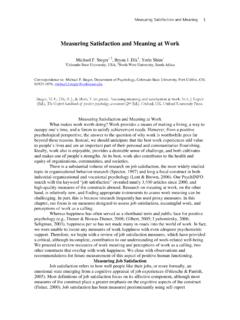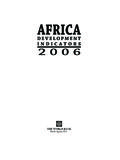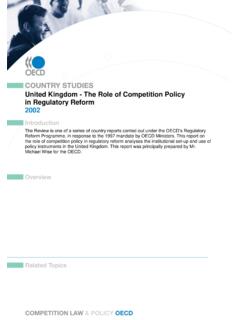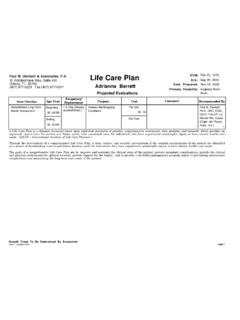Transcription of The Meaning in Life Questionnaire ... - Michael F. Steger
1 Journal of Counseling Psychology Copyright 2006 by the American Psychological Association 2006, Vol. 53, No. 1, 80 93 0022-0167/06/$ DOI: The Meaning in Life Questionnaire : Assessing the Presence of and Search for Meaning in Life Michael F. Steger and Patricia Frazier Shigehiro Oishi University of Minnesota Twin Cities Campus University of Virginia Matthew Kaler University of Minnesota Twin Cities Campus Counseling psychologists often work with clients to increase their well-being as well as to decrease their distress. One important aspect of well-being, highlighted particularly in humanistic theories of the counseling process, is perceived Meaning in life. However, poor measurement has hampered research on Meaning in life. In 3 studies, evidence is provided for the internal consistency, temporal stability, factor structure, and validity of the Meaning in Life Questionnaire (MLQ), a new 10-item measure of the presence of, and the search for, Meaning in life.
2 A multitrait multimethod matrix demonstrates the convergent and discriminant validity of the MLQ subscales across time and informants, in comparison with 2 other Meaning scales. The MLQ offers several improvements over current Meaning in life measures, including no item overlap with distress measures, a stable factor structure, better discriminant validity, a briefer format, and the ability to measure the search for Meaning . Keywords: Meaning in life, purpose in life, measurement, scale construction, well-being In recent years the construct of Meaning in life has received personal growth that counseling psychologists historically have renewed attention and legitimacy, perhaps in conjunction with a been interested in, particularly those influenced by the humanistic growing focus on positive traits and psychological strengths (Ryan tradition of promoting growth and not simply decreasing symp- & Deci, 2001; Seligman & Csikszentmihalyi, 2000 ).
3 Invariably, toms. The purpose of the present research was to develop an Meaning in life is regarded as a positive variable an indicator of improved measure of Meaning in life. well-being (Ryff, 1989), a facilitator of adaptive coping (Park &. Folkman, 1997), or a marker of therapeutic growth (Crumbaugh &. Maholick, 1964; Frankl, 1965). A recent report in the Journal of Overview of Meaning in Life Literature Counseling Psychology advocated for the understanding and as- The definition of Meaning in life varies throughout the field, sessment of well-being variables such as Meaning in life in order ranging from coherence in one's life (Battista & Almond, 1973;. to promote client growth and recovery (Lent, 2004). Despite Reker & Wong, 1988) to goal directedness or purposefulness ( , substantial progress over the 40-year history of empirical research Ryff & Singer, 1998 ) to the ontological significance of life from on Meaning and the resurgence presently occurring, existing re- the point of view of the experiencing individual (Crumbaugh &.)
4 Search seems unable to answer many fundamental questions about Maholick, 1964, p. 201). Others offer semantic definitions ( , the construct. We argue that better measurement will help advance What does my life mean? ; Baumeister, 1991; Yalom, 1980). this research by providing a measure of therapeutic outcome and Likewise, there is diversity in perspectives regarding how to achieve Meaning in life. Because there is no universal Meaning that can fit everyone's life (Frankl, 1965), each person must create Michael F. Steger , Patricia Frazier, and Matthew Kaler, Department of Meaning in his or her own life (Battista & Almond, 1973), whether Psychology, University of Minnesota Twin Cities Campus; Shigehiro through the pursuit of important goals (Klinger, 1977) or the Oishi, Department of Psychology, University of Virginia. development of a coherent life narrative (Kenyon, 2000 ; Mc- This research was supported by a Harrison Gough Graduate Research Adams, 1993).
5 Baumeister (1991) proposed that a feeling of mean- Grant to Michael F. Steger from the University of Minnesota. Portions of ing can be attained by first meeting needs for value, purpose, this article were presented at the 2nd International Positive Psychology efficacy, and self-worth. Others have indicated the importance of Summit, October 2003, Washington, DC, and at the Seventh European everyday decision making and action (Maddi, 1970) or of self- Conference on Psychological Assessment, March 2004, Ma laga, Spain. transcendence ( , Allport, 1961; Seligman, 2002) in the creation We thank Brandon Sullivan and Andrew Tix for their collection of some of Meaning . of the data used in these studies. We also thank Mark Snyder and Todd Kashdan for their helpful comments on a draft of this article. Despite these differences in definitions of, and routes to, mean- Correspondence concerning this article should be addressed to Michael ing in life, theorists uniformly regard Meaning as crucial.
6 Mean- F. Steger , University of Minnesota, Department of Psychology, N218 ingful living has been directly equated with authentic living Elliott Hall, 75 East River Road, Minneapolis, MN 55455. E-mail: (Kenyon, 2000 ), and in eudaimonic theories of well-being, which focus on personal growth and psychological strengths beyond 80. ASSESSING Meaning IN LIFE 81. pleasant affect, Meaning is important, whether as a critical com- aside from Meaning , such as mood. According to Clark and ponent (Ryff & Singer, 1998 ) or as a result of maximizing one's Watson (1995), items assessing nearly any negative mood term potentials ( , Deci & Ryan, 2000 ; Maslow, 1971). Frankl (1963) will covary highly with neuroticism. Empirical findings support argued that humans are characterized by a will to Meaning , an this idea, with disconcertingly high correlations observed between innate drive to find Meaning and significance in their lives, and the PIL and negative affect (.)
7 78; Zika & Chamberlain, 1987), that failure to achieve Meaning results in psychological distress. positive affect (.78; Zika & Chamberlain, 1992), and life satisfac- Research has supported this proposed link between lack of mean- tion (.71; Chamberlain & Zika, 1988b). Other Meaning measures ing and psychological distress. Having less Meaning in life has also are highly correlated with measures of positive and negative been associated with greater need for therapy (Battista & Almond, affect ( , Debats et al., 1993; Zika & Chamberlain, 1987). The 1973), depression and anxiety ( , Debats, van der Lubbe, & investigation of potential correlates, antecedents, and conse- Wezeman, 1993), and suicidal ideation and substance abuse ( , quences of Meaning in life is hampered if items are included in Harlow, Newcomb, & Bentler, 1986), as well as other forms of Meaning measures that tap these related constructs.
8 Distress. Having more Meaning has been positively related to work Furthermore, the factor structures of Meaning measures have enjoyment (Bonebright, Clay, & Ankenmann, 2000 ), life satisfac- been somewhat problematic. Empirical testing has revealed struc- tion ( , Chamberlain & Zika, 1988b), and happiness (Debats et tures different from those theorized for all of the measures of al., 1993), among other measures of healthy psychological Meaning that have been examined (see, , Chamberlain & Zika, functioning. 1988b; McGregor & Little, 1998 ). In addition, the factor structures Counseling psychology has traditionally focused on positive func- of often-used Meaning measures such as the PIL and LRI have tioning and human strengths, although more energy has been focused varied from study to study ( , compare Chamberlain & Zika, on adapting deficit or pathology-oriented models to the treatment of 1988a, with Reker & Cousins, 1979, and McGregor & Little, relatively well-functioning clients than to forging, testing, and apply- 1998 ), possibly owing to the presence of multiple content domains.
9 Ing models of psychological health (Lent, 2004, p. 483). Lent further Finally, given that Frankl's (1963) work, particularly Man's argued that greater inquiry into well-being could lead to development Search for Meaning , has been given credit for the emergence of of models of mental health that address the needs of practicing Meaning as an important variable (Wong & Fry, 1998 ), it is psychologists. Several counseling psychologists have commented on surprising that the search for Meaning in life has been all but the importance of Meaning in life and Meaning -related variables to the neglected. Maddi (1970) also argued that the search for Meaning is healthy personality (Day & Rottinghaus, 2003), psychotherapy (Gelso a fundamental human motivation. Crumbaugh (1977) designed the & Woodhouse, 2003), health psychology ( , Harris & Thoresen, Seeking of Noetic Goals Scale to assess the will to Meaning , but 2003), and career counseling (Savickas, 2003).
10 Meaning is one of a criticism of that measure has been severe ( , Dyck, 1987;. set of growth-related variables that are thought to provide the condi- Moreland, 1985), and it has gone almost completely unused. tions from which happiness arises (Lent, 2004; Ryff & Singer, 1998 ). We sought to address these concerns by developing a new Thus, Meaning may contribute to the foundation of overall client measure of Meaning in life. We defined Meaning in life as the happiness. Some clients may also present with a desire to become sense made of, and significance felt regarding, the nature of one's actualized and achieve a deeper sense of Meaning and purpose (Lent, being and existence. This definition represents an effort to encom- 2004). Further, the crises with which clients most often present offer pass all of the major definitions of Meaning and allows respon- opportunities for growth, and greater Meaning or purpose in life may dents to use their own criteria for Meaning .











